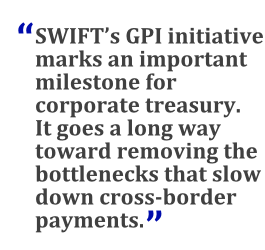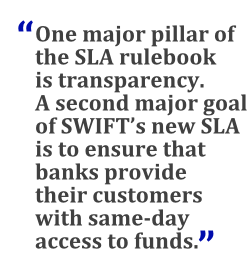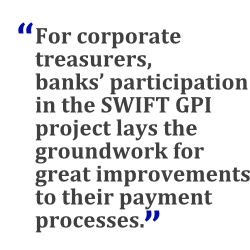 Digitization is gathering pace, and innovative paymentproviders are using new technologies to change the landscape of thefinancial services sector. Corporate banking customers aredemanding more and more efficiency and transparency in theircross-border payments. And the global correspondent bankingnetwork—the crucial facilitator of international trade—is underincreasing pressure to adapt.
Digitization is gathering pace, and innovative paymentproviders are using new technologies to change the landscape of thefinancial services sector. Corporate banking customers aredemanding more and more efficiency and transparency in theircross-border payments. And the global correspondent bankingnetwork—the crucial facilitator of international trade—is underincreasing pressure to adapt.
Banks have long been reliant on the payments infrastructureprovided by the Society for Worldwide Interbank FinancialTelecommunication, known more commonly as SWIFT, the global networkthat enables communication of financial information between banks.But the status quo is no longer acceptable. Financial institutionsthat want to remain competitive in the market for cross-bordertrade must embrace innovation.
|This is where SWIFT's global payments innovation (GPI)initiative comes in. The initiative commits banks to a higherstandard when facilitating cross-border payments, which helpscorporate banking customers grow their international business. Theinitiative's pilot program, which launched last April, marks avital step forward.
|
Technology Raising Treasurers'Expectations
In the past, a multinational company may have accepted waiting aday or two for a cross-border payment to clear. But in today'sbusiness environment, with its high-speed communications anddigitization of information, treasurers expect payments to processquickly. Speed is of the essence.
|At the same time, companies are expecting to receive greaterclarity and more comprehensive information from their bankingpartners. The complexities of trade, particularly as companies goglobal, mean that treasurers need to be able to easily track thestatus of all their transactions.
|Transparency supports a company's working capital efficiency,obviously, but that's not the only benefit. Payments transparencyalso helps companies nurture better relationships with theirtrading partners. For instance, if a buyer gets confirmation thatpayments to a supplier have been both made and receivedsuccessfully, it knows how to proceed in building and sustaining ahealthy trading relationship for the future.
| Andthe last—but by no means least—area in which corporate treasurersare expecting more from their banks: Companies are demanding thattheir banks provide comprehensive, reliable, and visibleinformation on banking fees.
Andthe last—but by no means least—area in which corporate treasurersare expecting more from their banks: Companies are demanding thattheir banks provide comprehensive, reliable, and visibleinformation on banking fees.
In light of these growing customer demands, most banks areworking hard to provide corporate customers with a modern, rapid,and user-friendly payments experience. They cannot run the risk offalling behind in the payments race. This is all the more crucial,given the pressure that the global correspondent banking network isalready under from increasing compliance costs, regulatoryintensity, consolidation of correspondent networks, anddisintermediation.
|Of course, within the SWIFT system, the process of actuallysending a payment already happens relatively quickly. Standardizedfinancial messages identify more than 11,000 banks and speedilyfacilitate the movement of funds between some 200 countriesworldwide.
||Yet procedures outside the core transfer of funds can stillhinder a straight and smooth process. Clearing, payments checking,compliance processes, and confirmation can all eat into a corporatebanking customer's precious time—not to mention threaten acompany's liquidity flows. For instance, if a bank is to complywith regulations, its employees must perform due diligence checkson the bank's customer and its customer's customers.
|Similarly, confirming the status of payment transactions—thatis, noting when they have been sent, received, and cleared—can be acumbersome process. Faster, automated flows of data between banksstand to speed up such procedures.
|
Transparency in the SWIFT Global Payments InnovationInitiative
That is why SWIFT's GPI initiative marks such an importantmilestone for corporate treasury. Announced at the end of lastyear, it goes a long way toward removing the bottlenecks that slowdown cross-border payments. The initiative, which embarked on itspilot phase in spring 2016, is already supported by over 70 globalbanks—Commerzbank among them.
| Atthe heart of the scheme is a new multilateral service levelagreement (SLA) rulebook, which commits banks using the SWIFTplatform to meet improved customer service standards whenfacilitating payment transactions.
Atthe heart of the scheme is a new multilateral service levelagreement (SLA) rulebook, which commits banks using the SWIFTplatform to meet improved customer service standards whenfacilitating payment transactions.
One major pillar of the SLA rulebook is transparency. Forinstance, under a mutually agreed set of business rules, banks mustoffer their customers full visibility on transaction fees. Thismeans providing insight into the fee structure and highlighting anyfees that might otherwise be hidden. This improved transparency isenabling customers of the banks participating in the pilot projectto better measure their transactions' cost and more effectivelyprioritize their banking relationships.
|Meanwhile, SWIFT's initiative also ensures that banks offertheir customers a wealth of information on payments. Banks mustprovide extensive end-to-end payment tracking. In this respect,SWIFT is developing a database, hosted in the digital “cloud,”allowing banks and their corporate customers to track their fundsfrom the initial transfer to confirmation of clearance in thebeneficiary's account. This will provide key insights into thestatus of payments, using a unique reference number to identifywhen they have been sent, received, and cleared—in the sort of wayan international shipping company may provide a parcel trackingservice to its customers. The result is that a buyer can enjoyconfirmations that its creditor has been paid, and companies onboth ends of a transaction will be able to dedicate fewer resourcesto investigations into the causes of slow payments.
|This new transparency may improve interactions—and buildtrust—among banks, sellers, and buyers. Thus, the initiative haspromise in enhancing long-term trading relationships and optimizingcross-border trade.
|SWIFT GPI Also Enhances Payment Speed
A second major goal of SWIFT's new SLA is to ensure that banksprovide their customers with same-day access to funds.
|Clearly, this will significantly improve the payment experiencefor customers at both ends of a transaction. An exporting company,for example, can rely on having money in its account (and thusbeing able to use it) the very day its transaction is processed.Such a simple yet vital development can help enhance a company'sliquidity, while boosting the customer's overall bankingexperience.
||While banks have always wanted to offer the fastest possiblepayment experience to their customers, cross-border commerce canstill be slowed down given the number of correspondent banksinvolved. The reason is that each bank in the chain may vary thespeed at which it processes transactions, calculates fees, anddraws up payment status information for its customers, all of whichcan result in unexpected delays.
|Yet by engendering a standardized, consistent process across allbanks involved, SWIFT's GPI initiative promises to ultimately speedup access to funds for the end customer.
|Achieving these gains does not require further technologicalinnovation from the banks. Instead, the scheme builds on existingbanking infrastructure, and SWIFT's proven messaging technology, toensure that banks best use their resources to service theircustomers. Certainly, some banks may currently take several days toclear cross-border transactions, but with over 70 major globalbanks currently participating, the drive towards best practice willdoubtlessly grow.
|
SWIFT Improvements Take the World byStorm
Banks participating in the GPI initiative must show that theycan meet SWIFT's requirements in terms of both speed of paymentsand transparency. After all, the scheme, is, at its core, acommitment to customer service. And the initiative's multilateral,open model is designed to be inclusive: It's offered to any bankworldwide that can meet the new standards of clarity and speed inprocessing transactions.
| Giventhat the major transaction banks already signed up to SWIFT GPIcover around three-quarters of the total cross-border paymentscurrently sent over the SWIFT network—in nearly 200 countriesworldwide—progress is well under way, and the advantages shouldhelp spur others to follow suit. The pilot project ends in Decemberof this year, with the building blocks already in place forsubsequent steps in 2017.
Giventhat the major transaction banks already signed up to SWIFT GPIcover around three-quarters of the total cross-border paymentscurrently sent over the SWIFT network—in nearly 200 countriesworldwide—progress is well under way, and the advantages shouldhelp spur others to follow suit. The pilot project ends in Decemberof this year, with the building blocks already in place forsubsequent steps in 2017.
For banks, the initiative represents a decisive move towardchampioning best practices globally. In many countries, the bankinginfrastructure and regulations already support efficiency andtransparency in domestic payments. The SWIFT GPI initiative has thepotential to drive best practice on an international scale.
|It also represents an opportunity for banks to build and securetheir trade business. By committing to the SWIFT standards fortimeliness and transparency in all payments, banks signed up to theinitiative are better placed to both retain customers and attractnew ones. At a time of increased competition for margins in worldtrade, the opportunity to grow volumes and market share in thetransaction business is worth grasping.
|The future of global trade depends on correspondent banking, sobanks must strive to raise standards for their corporate customers.SWIFT's GPI initiative offers global banks a means of demonstratingtheir commitment to transparency and same-day paymentclearing—thus, a means of differentiating themselves from thecompetition.
|For corporate treasurers, banks' participation in the SWIFT GPIproject lays the groundwork for great improvements to their ownpayment processes.
|——————————————–
| Ingrid Weisskopf is head of cash products andadvisory FI at Commerzbank. She took up the position in Frankfurt,Germany, in 2009.
Ingrid Weisskopf is head of cash products andadvisory FI at Commerzbank. She took up the position in Frankfurt,Germany, in 2009.
Complete your profile to continue reading and get FREE access to Treasury & Risk, part of your ALM digital membership.
Your access to unlimited Treasury & Risk content isn’t changing.
Once you are an ALM digital member, you’ll receive:
- Critical Treasury & Risk information including in-depth analysis of treasury and finance best practices, case studies with corporate innovators, informative newsletters, educational webcasts and videos, and resources from industry leaders.
- Exclusive discounts on ALM and Treasury & Risk events.
- Access to other award-winning ALM websites including PropertyCasualty360.com and Law.com.
*May exclude premium content
Already have an account? Sign In
© 2024 ALM Global, LLC, All Rights Reserved. Request academic re-use from www.copyright.com. All other uses, submit a request to [email protected]. For more information visit Asset & Logo Licensing.







